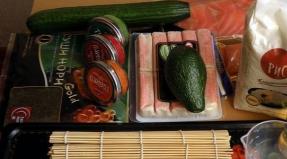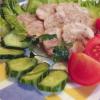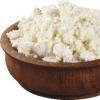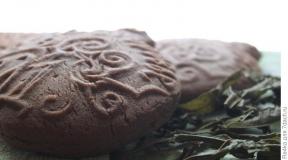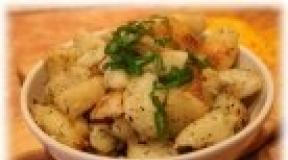What foods can be frozen in the freezer. What is frozen for the winter
1. Nuts
If you have purchased too many nuts and want to protect the oil they contain from spoiling, you can freeze them. When kept warm, the oil in them becomes rancid. Set aside as many nuts as you intend to eat and freeze the rest. Remove the nuts from the freezer if necessary; they will thaw quickly at room temperature.
2. Boiled rice

Have you boiled too much rice? Well, don't throw away the surplus. Place it in a container with a lid and freeze. If necessary, reheat in the microwave or on the stove with a few tablespoons of water. This method is also convenient for saving time. You can boil the rice in advance, freeze it, and then just reheat it.
3. Grated cheese

Many recipes require very little grated cheese. If you often sprinkle cheese on your dishes, then grate it every time. Do it smarter. Grate all cheese, divide into portions and freeze. Freezing will keep the cheese fresh for a long time. This method is only suitable for hard varieties.
4. Ripe bananas

Frozen ripe bananas are good for milkshakes. They are easy to grind in a blender and make a great addition to smoothies and add a creamy flavor.
5. Wine and champagne

If there is a little wine left in the bottle after the party, do not empty it. Freeze wine in ice cube trays. Cubes of frozen wine can be used to prepare various dishes, when stewing meat and fish. When making sangria, frozen wine cubes can be added to a jug of fruit and regular wine. Frozen champagne cubes can be added to cocktails.
6. Fresh bacon

Bacon thaws easily at room temperature, so store it in the freezer with a piece of parchment paper. Fried bacon cannot be stored this way.
7. Butter

Frozen butter is a chefs secret weapon. It is easy to grate when making dough and more. Freeze it directly in the package by placing it in a bag or wrapping it in foil.
8. Fresh herbs

Wash and dry the herbs. Chop finely, place on a tray and freeze. After the greens are frozen, transfer them to a bag. There is another option. Mix chopped greens with water and pour into ice cube trays. It is convenient to add frozen ice cubes with herbs to pans when preparing soups or other dishes.
9. Baking dough

Not only store-bought frozen dough can be stored in the freezer. The principle is the same with homemade dough. Divide the dough into pieces, roll into tortillas, place on a tray and freeze. Then place in bags in portions and store in the freezer.
10. Bread

Storing leftover bread in the freezer is not a good idea. But fresh can be frozen. If you have any excess fresh bread, cut into slices and wrap in foil. These slices are easy to defrost in the microwave or oven at 150 degrees.
11. Egg yolks and whites

Just like wine and herbs, egg yolks and whites can be frozen in ice cube trays. If you are going to add them to the dough, thaw them at room temperature. For omelettes, you can add directly to the skillet.
12. Whipped cream

Of course, it is better to eat the cream right away. But you can freeze them. Spoon the cream onto a tray of parchment paper and place in the freezer. Transfer the frozen cakes to a container and send back to the freezer. It is a great decoration for hot chocolate, coffee or cocoa. The whipped cream will melt right in the cup.
If stored properly, foods are beneficial to the body. Food can stay in the freezer for a long time without losing vitamins and other valuable elements. In the review, we will talk about what you can freeze for the winter, discussing the simple preparation of the most common foods at home. Ideal stocks in the freezer are represented by a universal assortment: vegetables, fruits, berries, herbs, mushrooms.
Rules for freezing food in the freezer
Features of storing food in the freezer
The rules for freezing food in the chamber are simple, but they must be strictly observed. Before freezing, it is required to prepare all products in such a way that later they do not have to be washed, but can be consumed immediately. If the shelf life is not observed, food poisoning occurs. Select only fresh, whole, undamaged, high quality food for freezing. It is advisable to turn on the maximum cold in the freezer a few hours before laying new products in order to create an optimal atmosphere there and the process of adding food at room temperature does not negatively affect the containers and bags already stored in the chamber. It is better to store food in portions so that you can get a little of them.
The average temperature in the freezer is 20 degrees and below. For some workpieces, 18 degrees is enough. Do not refreeze vegetables, fruits, berries or mushrooms that have already been defrosted. Each product needs a sealed container. Containers are available in abundance in supermarkets. You need to put the washed and dry product on a flat surface and freeze it slightly so that the pieces do not stick together. Next, send the blank into a plastic container or wrapper, remove air from there, close the package, place a label on it indicating the contents and today's date. This approach will provide you with convenience when using frozen foods.
Better to stock up without sugar and salt. Usually housewives, subject to all conditions, manage to preserve vitamins and provide the whole family with healthy food. Blanks for the winter can be whole, cut into pieces. Blanched foods also store well. This means that the food has been boiled for up to 5 minutes in a small amount of water.
Shelf life of food in the freezer
The length of time the food is kept in the refrigerator freezer varies. Here are the generally accepted norms:
- vegetables can be stored for 3-12 months;
- fruits are stored in the freezer for 9-12 months;
- greens are stored for 3-4 months;
- store mushrooms for 3-6 months;
- bell peppers stuffed with minced meat can be stored for 3-6 months.
Please adhere to the stated expiration dates, do not use expired products, always sign the dates of procurement, especially if you have small children.
Freezer packaging
You can dry vegetables and fruits before freezing with a cold hair dryer to speed up the process, or lay out washed food on fabrics.
You need to know what you can and cannot freeze food in. The following packaging options are relevant for vegetables, fruits, herbs and mushrooms:
- tight-fitting plastic containers;
- trays made of food grade plastic;
- plastic film;
- tin products specially for the freezer;
- extrusion film-polyethylene;
- aluminium foil;
- when it comes to berries, it is convenient to lay them out in ice molds;
- some products are successfully stored in paper boxes;
- food cellophane bags;
- bags equipped with clips.
And these packaging options are not suitable for storing food in the freezer:
- household bags and any fabric products;
- wrapping;
- garbage bags and bags and any non-food cellophane bags;
- greaseproof paper.
We have decided on the best packaging, now let's talk about how to properly freeze specific foods so that you can enjoy them later in the winter.
properly frozen vegetables and fruits do not lose their attractive appearance, taste, spectrum of vitamins and other useful substancesWhat vegetables can be frozen for the winter?
How to freeze a pumpkin for the winter?
It is not difficult to prepare raw pumpkin. First, remove the skin, then chop the pulp at random. For example, 2.5 centimeters cubes. We lay out the chopped vegetables on the tray so that the fragments do not touch. Otherwise, the pieces will stick together. When freezing occurs, the product should be transferred to a plastic container, taking into account that there is some free space, as this product expands when cooled. It is also convenient to freeze raw or boiled grated pumpkin.
Freezing zucchini correctly
We take the most tender young zucchini or zucchini, in which there are a minimum of seeds and they are small, thin skin. They need to be washed, dried, tails cut off. For freezing zucchini for soup or stew - cut them into cubes of 1-2 centimeters. For fried zucchini and casseroles, centimeter-thick circles are better. When preparing vegetable pancakes is being prepared, it is advisable to rub the zucchini together with carrots through a grater.
Storing beets in the freezer
Rinse the beets, remove the skins, chop them in any way. For example, chop, blender, or grate. Divide into small portions by placing the product in containers, bags or ice trays. Use the fast freeze function. Boiled beets are frozen in the same way.
How to freeze eggplants for the winter?
Soak the eggplants in water for a while, then chop them arbitrarily. Arrange in the selected packages and send to the freezer. You can freeze raw or oven-baked eggplants. The product is prepared by conventional blanching for up to 5 minutes, heating in the microwave at 800-900 W for 4 minutes. In addition, before freezing, eggplants are blanched in a double boiler, also up to 4 minutes.
Freezing onions correctly
Peel the onions, make 0.5-1 cm slices, arrange them in packages, leaving a little free space. If possible, remove air from the bag, close it and send the product to the freezer. You can pre-blanch or fry the onions. You can also store leeks, chives, and green onions in the freezer. The frozen product is not used raw, it is added when preparing dishes.
Storing broccoli in the freezer
Separate the cabbage inflorescences, rinse them. Take small portions and process separately. Put the product in boiling water, keep in the cooking mode for 2-3 minutes, then put the cabbage in ice water for a couple of minutes. Place the product in a colander to drain off the water. Place the cabbage in sachets in portions, squeeze out the air and close them, put in the freezer.
How to freeze tomatoes for the winter?
For pizza, French meat, or omelet, you can cut the tomatoes into slices and place them in the freezer on edible paper. The frozen rings can be folded into any convenient container. It is convenient to store whole tomatoes - they are washed, dried and put in the freezer. To prepare only the pulp of tomatoes, you need to dip them in hot water, remove the skin and use the insides. You can also make tomato juice and freeze it, use it for various homemade dishes.
Properly freezing carrots
Cut the carrots into pieces of any shape. For beauty, you can use curly devices for cutting vegetables. If this is not the case, then you can make circles, cubes or thin straws. Freeze absolutely dry carrot slices so that they do not stick together into a single mass. Place the carrots on a cutting board, wait a couple of hours, then place them in any packaging. In addition, vegetables can be blanched - cook in boiling water for about 2-3 minutes, then remove and immediately put in cold water, dry on a towel and freeze in the same way.
Storing peppers in the freezer
Whole and even-skinned peppers, freed from stalks and seeds, wash and dry well. Place the product freely on the substrate, when after a few minutes it freezes, fold tightly into any container for storage. For example, in plastic bags. And the peppers are harvested like this: they are dipped in boiling water for half a minute, then they are dried and frozen, folding them one into the other. Such a product is suitable for preparing stuffed peppers or adding to various dishes.
How to freeze potatoes for the winter?
Peel the potatoes and put them in water immediately, otherwise they will darken. Small tubers, if desired, are frozen whole: boil the product in boiling water for five minutes, then put it in ice water, remove, dry thoroughly and place in the freezer in zipper bags or ordinary plastic bags. Two-stage freezing - first, lay the tubers on a horizontal surface freely, wait for freezing, then put them more tightly in any container. When preparing dishes, you do not need to defrost potatoes, put them immediately in the dishes. In a similar way, you can prepare potatoes in strips, only the blanching is 3 minutes and the raw product must be rinsed more thoroughly. Pack the frozen slices in bags. Such a product is a base for fries or a component of soups. If potato slices are prepared specifically for deep-frying, then it is advisable not to blanch them, but to steam them in a colander over boiling water in a saucepan and sprinkle with oil before freezing. Some freeze ready-made fries.
Celery freezing rules
Rinse celery and remove coarse fibers. Freezing the product whole or in pieces allows you to add it to sauces, stews, soups. You can prepare celery without or with blanching. This is because blanching for 3 minutes will extend the shelf life. Arrange dry pieces on foil or parchment, freeze them, then pack them in a convenient way and send them to the freezer for storage. Store the product for 2 months without blanching, and up to a year with blanching.
How to properly freeze fruits and berries in the freezer?
Freezing strawberries
The berries lose their taste a little, so many people freeze it in sugar. First spread the product in a thin layer, after freezing, put it in bags or plastic containers. If you need to make strawberries not in bulk, but with sugar, we take 350 grams of sand or powdered sugar per kilogram of product. We put clean berries in a plastic bowl, pouring sugar over each layer. After keeping for a couple of hours at above-zero temperature in the refrigerator, the berries will give juice, then tightly fold the berries into any container and pour the juice, they will be tasty and sweet, as they are in syrup. Also, strawberries are perfectly stored in the form of mashed potatoes. To do this, the berries need to be kneaded or passed through a blender. When the puree contents of the container are thawed, then sugar is added.
Freezing plums in the freezer
The tightest ripe fruits are selected for freezing. When you prepare the filling, the seeds will have to be removed. First, you need to keep the fruits laid out on a horizontal surface for several hours, then you can put them away for storage in any container. Plums do not need to be thawed before use. For example, put frozen pieces in compote or pie filling.
Harvesting and storing apples in the freezer
To make slices of apples, you need to cut out the stem and seeds, although this is not necessary. Put the cut fruits on a cutting board in one layer, put them in the freezer for 2 hours, then put them in a tightly closed plastic container or bags for further storage. You can also prepare the fruits in sweet syrup, their shelf life will be longer. First, we cook a syrup consisting of 1500 mg of ascorbic acid, 750 g of water, 450 g of sugar. Soak in cold syrup for a day, then pour boiling water over or blanch, and then freeze. In addition, you can make a puree mass, for this, cut apples without sugar are boiled for up to 20 minutes, then passed through a blender, and frozen. If you want, put the apples in the freezer whole. Before this, it is advisable to soak the fruits for several minutes in a solution consisting of 50 g of water and 1500 g of ascorbic acid.
Storing grapes in the freezer
Rinse and dry the grape brush with a towel, it does not give juice, which is different from raspberries, strawberries. First, freeze each brush separately, then they can be combined and stored in containers, bags. You can also prepare individual berries, they are also laid out on the surface, you can put them in bags on plates when they freeze a little and tie them tightly.
Harvesting cherries for the winter in the refrigerator
Freeze cherries with pits if you need to make jelly, compote, desserts, jelly from them. If you need pitted berries, for example, for filling pies, you will have to remove them before freezing. Cherries are not defrosted, they are immediately put in pies. For harvesting in the freezer, freshly picked berries are used, one serving of berries is 500 grams. The fruits must be washed and dried. The berries are stored in plastic boxes or sealed bags. First, the cherries are frozen in one layer, then the hard berries are transferred to a container, otherwise they can stick together. It is good to have a berry assortment of cherries, blackberries, currants and raspberries in the freezer, but all berries should be barely ripe, so they are better stored.
Storing food in the freezer: properly prepared vegetables, fruits, berries, mushrooms, greens are useful reserves for the winterHarvesting and storing mushrooms at home
How to properly freeze oyster mushrooms?
Oyster mushrooms are harvested in the same way as vegetables. The main thing is to take the product of the first freshness, rinse it clean, dry it well and pre-freeze it unfolded. Small mushrooms can remain intact, large ones need to be cut. In principle, it is permissible to freeze oyster mushrooms not in two stages, but to immediately remove them in containers or bags at the lowest temperatures. In addition, mushrooms can be boiled in salted water for a quarter of an hour, then dried and sent to the freezer. Try freezing and flavored mushroom broth.
Features of freezing mushrooms of camelina
Camelina mushrooms are a healthy product, ideal for freezing. Do not mix them with other mushrooms or tamp them in bags right away. It is necessary to keep the mushrooms at the maximum freeze for up to 12 hours, then transfer them to containers or bags and set the temperature to about 18 degrees.
Features of freezing greens
Take a look at our tips for storing greens in the freezer and using the blanks:
- use frozen herbs for teas;
- put greens in soups all year round;
- try freezing greens in a bunch, wrapping it in cling film, while you can cut the required amount from the resulting solid sausage;
- do not forget to freeze dairy corn with coarse grains along with greens;
- make an assortment of several types of greens (sorrel, parsley, dill, tarragon, sage and any other types), chop it finely and fill it with water, as a result, you will get convenient ice cubes in any container;
- it is convenient to freeze greens, chopped with a mixer, in trays for making ice.
It's great if your whole family gets used to eating greens in all seasons.
What shouldn't be frozen in the freezer?
- watery foods, such as cucumbers, potatoes, apples, watermelons - can be frozen, but it is possible that after thawing they will lose their shape;
- herbs - it is also, in principle, permissible to freeze, then they can change color and turn into porridge after thawing;
- horseradish, cheese - can behave in an unexpected way when frozen and thawed;
- do not freeze thawed meat;
- boiled pasta cannot be frozen;
- coffee beans lose their beneficial properties in the cold;
- canned food is not intended for storage in the freezer;
- do not freeze eggs in their shells, only in tins;
- sour cream, yogurt, custard and other creamy foods are stored in the refrigerator, not in the freezer;
- cheeses should not be frozen;
- sauces based on starch or flour cannot be frozen;
- ice cream that has melted does not need to be put in the freezer, otherwise it will become sticky;
- many are interested in whether it is possible to freeze cabbage, we believe that it is not worth doing this for salads, since the product loses its natural crispy structure, becomes sluggish and soft (although for cooking cabbage rolls, borscht and stews, white cabbage can be frozen with a head of cabbage or in chopped form )
- some housewives do not recommend freezing quince, melons, pears, hawthorn and rose hips, but we believe that quince, melon and pear are easily and permanently frozen similarly to other fruits - in cubes or slices by the dry method, and hawthorn with rose hips - are frozen with whole dry berries, also in a two-stage method (first, the products laid out in a thin layer are frozen, then they are transferred to a container for storage).
Our article discussed the topical issue of preparing food in the freezer. Adhering to simple rules, you can make your life much easier, diversify your home cooking and get vitamins continuously.
Chefs and housewives alike agree that groceries are not cheap today. Therefore, when we see our favorite product on sale, our first desire is to buy more. We always need some products, both for everyday cooking and for culinary delights on holidays. Therefore, it would be logical to purchase them in large quantities. But the same logic tells us that buying ten packs of butter or twelve loaves of cheese at once is not a good idea.
On the other hand, if you are planning on using all of these products over the next year, do not hesitate. Because the freezer is your new best friend. Below is a list of the main products that you didn't know much about.
Surprisingly, some foods that we do not think of storing at low temperatures not only tolerate it well, but they are even better stored in the freezer. Have you seen a sale of nuts in the store at 10 rubles per kilogram? Take as much as you can carry! Does your garden have a lot of greenery? And there is a place for her in the freezer. In fact, almost any product can be frozen and thawed without harming its flavor and health benefits. If saving money doesn't seem like enough motivation for you, think about how you can divide ready meals into portions, freeze them and thus not overeat.
With aluminum foil, plastic bags and film, food can be stored for months. So pop into the refrigerator and make room for your new supplies.
Here are 15 foods you can freeze
Milk
Bought 5 liters of milk, and now it's time to go on vacation? It will not be lost! Milk can be frozen, but you need to follow some rules. Pour some milk out of the bottle so that when it begins to freeze, it has room to expand in volume. After returning home, transfer your frozen milk to the refrigerator for a day or two. It is best to freeze fresh milk and keep it in the freezer for no longer than 4-6 weeks.
Butter
Frozen butter is especially useful if you bake a lot. Everything is very simple. Place the wrapped butter in a plastic bag or wrap tightly with foil and refrigerate overnight before use. Butter is usually stored in the freezer for no longer than six months, although there have been times when it has remained delicious for up to a year.
Nuts
Are you still freezing the nuts? It’s in vain. If you need to keep several types of nuts on hand for different dishes at all times, a freezer is the best solution. Nuts (especially peeled) contain a lot of fat, and therefore quickly deteriorate and become bitter under the influence of high temperature, humidity, light or even metal. Store nuts in a vacuum plastic container. Unshelled nuts can last up to eight months in the freezer. Just remember that one bitter nut can ruin your entire meal, so be sure to try them before using.
Cheese
Any hostess who has ever organized a party knows how convenient it is to serve cheese platters to guests. Therefore, if you stumble upon a cheese sale, feel free to buy more. Cheese can be stored in its original packaging, tightly wrapped in plastic wrap or aluminum foil. Soft cheeses and spreads are stored in the freezer for a month, but hard cheeses - up to six months. Remember to refrigerate frozen cheese overnight before serving.
Bakery products
Bread, cookies, cakes, pies, whatever! Your freezer will handle all of these foods. Freezing is a great way to prepare for a party ahead of time, or to hide excess sweets away. After cooling, wrap each cookie in plastic wrap and fold into a vacuum container. So they can be stored for up to a month. Uncut cakes or brownies can also be wrapped in plastic and placed in the freezer for three months, and thawed at room temperature. Purchased bread or muffins should be chilled in the refrigerator without opening the package, and then transferred to the freezer, where they can spend up to two months. You can use the microwave for quick defrosting. Alternatively, you can freeze raw dough and then quickly defrost it to bake something.
Flour
Pesto
If you're unsure of what to do with your huge stocks of basil, store it in pesto form. Prepare the sauce, spoon it over the ice cube trays and freeze. After the pesto is frozen, the cubes can be folded into a plastic vacuum container and stored for 6-8 months. To defrost the sauce, take the required number of cubes and let them stand at room temperature or in the refrigerator.
Greens
Let's say your garden has greens and herbs this year. Sometimes, after drying, they lose their taste. Freezing fresh herbs helps to preserve their taste and smell as much as possible. The greens can be cut into portions before freezing. Spread the herbs on a baking sheet, cover with a sheet of baking paper and place in the freezer. After the greens are frozen, transfer them to a vacuum plastic bag and store until you need them. You can also place chopped greens in ice cube trays and fill halfway with water. Cubes of frozen greens can be added directly to cooking, and mint can be added to iced tea or cocktails.
Cream cheese and sour cream
In the case of frozen cream cheese, there are some restrictions. If you plan to spread it on your bread in the morning, it is best not to put the cheese in the freezer, as the cold will change its consistency. However, if you are using cheese for cooking or baking, frozen cheese is fine. It can be stored in the freezer in its original packaging for up to three months. With sour cream, freezing works according to the same principle: it freezes easily, is great for cooking, but changes its consistency. We recommend whipping the sour cream before freezing to properly distribute moisture in it, and after thawing in the refrigerator to return it to its former shape (for this, you can also add two tablespoons of starch to the sour cream). Sour cream is stored in the refrigerator in a store package and a vacuum plastic bag for three months.
Jam
Each of us in the cold winter dreams of a spoonful of sweet homemade jam, and it is also very convenient to freeze it. Just fill the jar with jam and put it in the freezer! It does not expand much at low temperatures. To defrost the jam, place the jar in the refrigerator overnight. Enjoy fresh jam throughout the year, after which it will begin to lose flavor.
Rice
Cooked rice can be quickly frozen and then used as needed. Let the rice cool, then transfer to a container or plastic bag. For defrosting, the rice is transferred to a bowl with a little water and heated in the microwave.
Wine
If you still have unfinished wine, do not empty it! Instead, it can be poured into ice cube trays or a plastic bag and frozen. Freezing will not affect its taste or smell in any way, and you will always have wine for sauces on hand.
Eggs
To freeze eggs, break them into a bowl, beat lightly and pour the resulting mixture into ice molds or a plastic bag. For baking, you can freeze the yolks and whites separately.
Tomato paste
How many times have you had to buy a whole can of tomato paste for just a few tablespoons required by a recipe? Next time, try freezing the leftovers in an ice cube tray. Now, when you prepare your next spaghetti sauce, the pasta cubes will always be at your fingertips.
Fresh juice
During citrus season, you can squeeze out as much delicious juice as you want and then freeze it. For example, you can pour the juice into ice molds and insert a stick into each of them, so you get a healthy ice cream.
Now you see that by freezing many products, you can not only save money, but also simplify the cooking process. We hope you find our tips helpful!
You can get the required amount of valuable vitamins in winter, for this you should take care of freezing vegetables in the summer-autumn season. Frozen zucchini, tomatoes, broccoli, peppers and other foods retain their fresh aroma and the full range of vitamins, but you need to know how to freeze them correctly so that they delight with their taste and benefit the body.
How to freeze vegetables for the winter: little tricks
It is very convenient to store vegetable products in the freezer for further use in the winter season. So the hostess always has the necessary assortment, from which you can prepare a wide variety of dishes. In order for vegetables to bring maximum benefit after home freezing, you need to take into account some rules.
- Temperature indicators... If you want to keep frozen vegetables for the entire winter season or more, keep the temperature in your freezer under control. The optimal indicator is from 18 to 23 degrees below zero.
- Small volume... Do not freeze great amount vegetables in one bag or container, because in the future it will be inconvenient for you to use a vegetable semi-finished product. Take into account the fact that defrosted food pieces can no longer be returned to the freezer. The best solution is to freeze as much food as you need for one particular dish.
- Correct and convenient dishes (packaging)... Freezing any vegetables is best done in small plastic freezer containers or tight plastic bags for freezing. For these purposes, special bags with a lock are perfect.
- Marking... Mark the name of the product on the packaging, as after freezing, many vegetables change their color and it will be difficult for you to find what you need.
How to properly freeze vegetables for the winter: the preparatory stage
To prepare vegetables for the winter, it is important not only to take into account the above conditions for successful freezing, but also to choose and prepare the food correctly for this process.
- Vegetables must be ripe, fresh and free from defects.
- Freeze clean and dried food.
- Some types of vegetables should be blanched before being sent to the freezer - this stops the oxidative process inside the product, which improves its taste.
- Dried foods should be chopped, cut into cubes, circles or half rings, and then placed in prepared dishes or packaging.
The process of defrosting the product must exclude temperature extremes. This is best done in the refrigerator 2-3 hours before using the ingredient in the recipe.
Freezing different types of vegetables correctly
Cauliflower and broccoli
First, rinse the cabbage under running water using a colander. Then divide into inflorescences of the desired size and pour over with boiling water, then lower them in cold water, dry and pack for storage in the freezer. You can make a lot of hearty meals out of these types of cabbage, which will also be useful for children.
Bell pepper
First of all, the vegetable needs to be washed, dried and get rid of the core with seeds. The product is frozen both in whole form and in crushed form. In the first case, you need to carefully lay out the vegetable in packages so as not to damage the shape, in the second - cut into strips or cubes and place in a convenient container. The blank can be added to soup, salad, stew, or used as a base for stuffing.
Zucchini
They need to be washed from dirt and allowed to dry. If you expect to cook delicious stew, pancakes or soup from frozen zucchini, then cut them into cubes and pack. For frying or baking in the oven, each zucchini is cut into slices no more than 1 cm thick. Next, we make the so-called puff cake from the circles, and instead of the layer we use plastic wrap. Place the resulting "cake" in the freezer for 8-10 hours, after which we carefully separate the circles from the film and put them in containers. Frozen zucchini can be used as baby food, for this it is worth defrosting and boiling the vegetable, making mashed potatoes and offering the toddler.
Green pea
It is convenient to freeze a ripe product in bags, having previously freed the peas from the pod. It does not need to be thawed before use - you can immediately cook it in soup, pilaf or stew.
Eggplant
Clean and dried vegetables are frozen in the same way as zucchini. Frozen eggplant will be delicious when fried or added to a stew.
Tomatoes
Freezing small tomatoes, such as cherry tomatoes, is very simple: The clean tomatoes are packed whole in bags and kept in the freezer until used. Large tomatoes should be cut into slices and layered with foil in the same way as for freezing zucchini or eggplant. Such tomatoes are an excellent semi-finished product for making red sauces, pizza, pasta, stews.
Carrot
The root crop is cleaned of dirt and dried, then rubbed on a coarse grater, packed and sent to the freezer.
Convenient workpiece
Your favorite dish with frozen vegetables is easy to prepare, as cleaning and slicing are excluded. Such semi-finished products save time and effort of housewives. At home, you can create mixtures of vegetables that combine foods for a particular dish.
- Soup mixture: peas, carrots, broccoli (cauliflower).
- For the moussaka casserole: tomato and eggplant.
- For stews: carrots, tomatoes, peppers with zucchini.
- For pilaf: a mixture of carrots, peas, zucchini and pepper.
- For ratatouille: tomatoes, eggplants, zucchini, bell peppers.
Vegetable mix is an excellent preparation from frozen products, with it you can create mouth-watering and bright dishes without spending a lot of effort.
Comment on the article "How to properly freeze vegetables for the winter"
Freezing my own vegetables was not impressive - I don't like the result in cooking later. It is more delicious to buy fresh zucchini even in winter. Freeze for the winter. Blanks for future use. Cooking. Cooking recipes, cooking help and advice, holiday menus and reception ...
Discussion
And we freeze everything) Any berries from the dacha - currants, gooseberries, cherries, club-nick, raspberries (I love it most of all - I defrost it in winter and as fresh). I cut parsley, dill, cilantro, sorrel into bags and also in the freezer. And I also buy meat, twist minced meat and make cutlets, which I also freeze, put in bags of 6-8 pieces, and then take out the right amount and fry - they really help out when you need to cook something quickly.
Oh, we all freeze. I cut carrots, peppers, herbs, eggplants in a food processor. More fruits and berries
Cherry. Freezing. Blanks for future use. Cooking. Recipes, cooking help and advice, festive menus and hospitality, food choices.
Discussion
I only freeze tomatoes in the 1st form - passed through a meat grinder, pour it in portions (for 1 pot of borscht), in plastic bags and a stack of them in the freezer.
can
I stopped cutting and skinning tomatoes before freezing. I ice it whole.
only now, does it make sense to freeze cherry? they are good fresh, in salads. and ice creams only go to cooking. can still learn to pickle or pickle?
Provision of vegetables for complementary foods .. Nutrition, introduction of complementary foods. A child from birth to one year. Here is a neighbor gave back a zucchini. half ate, and the other half can be frozen for the winter. But then I started thinking, is it worth doing all this?
Discussion
I froze the pumpkin and zucchini. I cleaned it, took out the seeds, cut them into cubes, put them in a bag and put them in the freezer. Plus, I rubbed the carrots in large strips in a food processor and also froze them. As needed, I took out several pieces of vegetables + potatoes + carrots + something else in the house (flower, broccoli, white cabbage) and in a slow cooker for 20 minutes. (double boiler mode). Then she chopped everything with a blender, salted a little, olive oil and put it in the child's mouth :) Leftovers in the refrigerator. I did it for 3 days. Then the yolk began to be added to the vegetables.
I freeze all the berries from the garden and some vegetables too
Freezing. And what vegetables do you freeze for the winter? And How? I just want to freeze the whole pepper, naturally without entrails, for further stuffing. Do you need to cook it first?
Freeze vegetables in the refrigerator. ... I find it difficult to choose a section. Household. Housekeeping: advice on housekeeping, cleaning, buying and using household appliances, repairs, plumbing.
Discussion
We freeze peppers, carrots, eggplants, berries, mushrooms. We pack everything in small portions in bags, there is no smell. It is convenient to have frozen vegetables on hand, there are probably some savings too.
We do not store meat, fish, firstly, we are not particularly meat-eaters, and secondly, you can always buy it if you really want to.
I ice: peppers, eggplants, zucchini, tomatoes, berries, mushrooms.
I freeze vegetables cut, prepared for cooking, portions at a time in a bag.
I pour small berries into a bag of about a liter. You can even freeze in bags of juice or milk, then take them out, transfer them to plastic bags. It is more convenient to store this way. I also freeze mushrooms, which are almost ready.
The smell was from root vegetables. In my opinion, there is no point in freezing them. Especially potatoes. The one that is sold as ice cream at the factory undergoes special processing. And potatoes, carrots, beets - they live well and so on until spring, in a cool dry place.
It is necessary to freeze something that is either expensive in winter or not bought at all.
I have a 140 liter freezer. 2 large drawers, a large and a small shelf (2 times smaller than a large one). One box is filled with all sorts of meat, etc. Other berries and vegetables. Small shelf: mushrooms, ice cream, semi-finished products (cheese cakes, stuffed peppers, minced meat). On a large shelf there are 15 kg of chicken legs for a dog :))) And everywhere, where ready-made ice cream mixes fit.
Freezing vegetables. Girls, I’m coming to you from the next conference. The question is probably not rare here, but I did not find anything specific on the search. I decided here to freeze a four-string of vegetables for the winter, and apart from pepper and a tomato, nothing is invented.
Discussion
I always cook, peel and ice small carrots. Quickly cut into soup. Great time savings when cooking, however :-)))
I just froze apricots, green beans, greens. I didn’t like the strawberries, except in her compote afterwards, zucchini and eggplant only in the stew. I will freeze the plum. I will have cauliflower, carrots, peppers. by the way, so that all this takes up less space, I fold it into bags flat, put a thick straw in there, hold it with my hand, suck air out of the bag, then tie it. the package becomes flat and compact.
Some foods should only be stored in the freezer. Freezing will not only protect them from spoilage and help you save money, but will also preserve the maximum nutrients in the food.
Below is a list of 15 foods you can and may even need to store in the freezer.

